Debonding Size Estimation in Reinforced Concrete Beams Using Guided Wave-Based Method
Abstract
1. Introduction
2. Debonding Size Estimation Using Guided Waves—Theoretical Background
2.1. The Influence of Damage Length on Wave Velocity
2.2. The Influence of Circumferential Debonding Size on Wave Velocity
2.3. The Influence of Circumferential Debonding Size on Wave Velocity
3. Experimental Investigation
3.1. Description of Experimental Models
3.2. Nondestructive Tests
4. Proposed Algorithm of Debonding Area Estimation
- The first step is determining the material and geometric parameters of the monitored structure and calculating the dispersion curves for the reinforced steel bar and RC cross-section. The curves are indispensable to determine the velocities cf and cb. If possible, the velocities can be also determined experimentally, which eliminates the necessity of curves’ trace calculations. In the presented study the theoretical velocities and were 4760.1 m/s and 2919 m/s and experimental velocities and were 4761.9 m/s and 3472.2 m/s, respectively (compare Section 3.2).
- The second step is an identification of the first arriving waveform, determining its ToF and calculating the average velocity ca in the investigated beam. In the experimental tests the wave velocities in particular beams for the excitation frequency of 80 kHz were as follows (Table 1):
- The last step is the calculation of the total debonding area Ad or the relative debonding area ar with the use of Equations (10) or (13). On the basis of the experimentally determined velocities in the previous step, the ratio ar has been established for each beam and compared with the exact debonding area (Table 2). The calculations were performed using two different data sets. In Equation (13) experimental velocities and were substituted and the ratios were calculated. The results are presented in the third column in Table 2. Next column contains absolute errors calculated using the formula:
5. Discussion of Aspects of Practical Application
- Tracing the dispersion curves. Tracing the dispersion curves requires knowledge regarding the material parameters of steel and concrete. In the case of the investigation of the real object it is usually possible to establish their values on the basis of the design documentation. Otherwise, additional experimental destructive or nondestructive tests (e.g., conducting ultrasonic pulse velocity tests) on specially prepared samples removed from the structure, e.g., by core drilling, would be necessary.
- Excitation of the longitudinal modes. In the experimental research, waves were excited only longitudinally in the middle of the beam cross-section. For this reason, all theoretical reasoning presented in Section 2 was conducted for longitudinal modes (see Figure 1). In fact, it is not always possible to uncover the rod to attach the sensor and actuator to excite waves along its axis. The solution might be to use embedded transducers, however, this approach has serious practical limitations. From the practical point of view, the preferred solution would be attaching the transducers at the bottom or top beam surface and exciting waves perpendicularly to the specimen axis. In such a case flexural modes are also excited in the specimen. Their propagation must be taken into account during determination of the velocities of the fastest modes.
- Complex shape of the reinforcing bars. The bars investigated were smooth and straight, meanwhile complex geometry of the bars as well as the presence of additional reinforcement, such as stirrups, triggers additional wave reflections, and wave modes’ conversions, which undoubtedly affect the registered signals. Thus, the application of guided waves in damage detection in RC structures requires detailed recognition of the propagation phenomenon in specimens characterized by the complex geometry.
- Significant size of the investigated specimen. The experimental research has been performed on beams 50 cm long. Reinforced concrete beams are usually characterized by a greater length, which entails stronger wave attenuation. The debonding detection in actual engineering structures involves the necessity of generating high-energy excitation. In this study we used a single transducer with a free stroke of 3.3 µm and blocking force of 378 N to actuate the guided waves. The input signal driving the actuator was characterized by the amplitude not exceeding 10 V, while the maximum voltage for this transducer was 150 V. It means that for the same hardware configuration, the input signal can be multiplied by 10–15 times. Additionally, if necessary, a single actuator can be replaced by a piezoelectric stack, which allows for an additional increase of input wave amplitude up to 10 times. With the current technical parameters of piezo-actuators, testing of longer objects is possible with adequate amplifying of the excitation. Moreover, the analysis can also include the study of attenuation curves, which illustrate the intensity of wave damping depending on the excitation frequency. On the basis of the attenuation curves, the preferable frequency ensuring the low wave attenuation can be chosen.
6. Conclusions
Author Contributions
Acknowledgments
Conflicts of Interest
References
- Giurgiutiu, V. Structural Health Monitoring with Piezoelectric Wafer Active Sensors; Academic Press: Cambridge, MA, USA, 2008. [Google Scholar]
- Li, D.S.; Zhang, S.; Yang, W.; Zhang, W. Corrosion Monitoring and Evaluation of Reinforced Concrete Structures Utilizing the Ultrasonic Guided Wave Technique. Int. J. Distrib. Sens. Netw. 2014, 10, 1–9. [Google Scholar] [CrossRef]
- Na, W.B.; Kundu, T.; Ehsani, M.R. Ultrasonic guided waves for steel bar concrete interface testing. Mater. Eval. 2002, 60, 437–444. [Google Scholar]
- Aggelis, D.G.; Shiotani, T.; Momoki, S.; Hirama, A. Acoustic Emission and Ultrasound for Damage Characterization of Concrete Elements. ACI Mater. J. 2009, 106, 509–514. [Google Scholar]
- Popovics, J.S.; Rose, J.L. A survey of developments in ultrasonic NDE of concrete. IEEE Trans. Ultrason. Ferroelectr. Freq. Control 1994, 41, 140–143. [Google Scholar] [CrossRef]
- Lu, Y.; Li, J.C.; Ye, L.; Wang, D. Guided waves for damage detection in rebar-reinforced concrete beams. Constr. Build. Mater. 2013, 47, 370–378. [Google Scholar] [CrossRef]
- Mustapha, S.; Lu, Y.; Li, J.C.; Ye, L. Damage detection in rebar-reinforced concrete beams based on time reversal of guided waves. Struct. Health Monit. 2014, 13, 347–358. [Google Scholar] [CrossRef]
- Wang, C.S.; Wu, F.; Chang, F.K. Structural health monitoring from fiber-reinforced composites to steel-reinforced concrete. Smart Mater. Struct. 2001, 10, 548–552. [Google Scholar] [CrossRef]
- Na, W.B.; Kundu, T.; Ehsani, M.R. Lamb waves for detecting delamination between steel bars and concrete. Comput.-Aided Civ. Infrastruct. Eng. 2003, 18, 58–63. [Google Scholar] [CrossRef]
- Beard, M.D.; Lowe, M.J.S.; Cawley, P. Ultrasonic guided waves for inspection of grouted tendons and bolts. J. Mater. Civ. Eng. 2003, 15, 212–218. [Google Scholar] [CrossRef]
- Wu, F.; Chang, F.K. Debond detection using embedded piezoelectric elements in reinforced concrete structures—Part I: Experiment. Struct. Health Monit. 2006, 5, 5–15. [Google Scholar] [CrossRef]
- Wu, F.; Chang, F.K. Debond detection using embedded piezoelectric elements in reinforced concrete structures—Part II: Analysis and algorithm. Struct. Health Monit. 2006, 5, 17–28. [Google Scholar] [CrossRef]
- Wu, F.; Chan, H.L.; Chang, F.K. Ultrasonic guided wave active sensing for monitoring of split failures in reinforced concrete. Struct. Health Monit. 2015, 14, 439–448. [Google Scholar] [CrossRef]
- Kim, S.D.; In, C.W.; Cronin, K.E.; Sohn, H.; Harries, K. Reference-free technique for debonding detection in CFRP-strengthened RC structures. J. Struct. Eng. 2007, 133, 1080–1091. [Google Scholar] [CrossRef]
- Li, J.; Lu, Y.; Guan, R.; Qu, W. Guided waves for debonding identification on CFRP-reinforced concrete beams. Constr. Build. Mater. 2017, 131, 388–399. [Google Scholar] [CrossRef]
- Wang, Y.; Zhu, X.; Hao, H.; Ou, J. Guided wave propagation and spectral element method for debonding damage assessment in RC structures. J. Sound Vib. 2009, 324, 751–772. [Google Scholar] [CrossRef]
- Sharma, S.; Mukherjee, A. Longitudinal guided waves for monitoring chloride corrosion in reinforcing bars in concrete. Struct. Health Monit. 2010, 9, 555–567. [Google Scholar] [CrossRef]
- Li, D.S.; Ruan, T.; Yuan, J.H. Inspection of reinforced interface delamination using ultrasonic guided wave nondestructive test technique. Sci. Chin. Technol. Sci. 2012, 55, 2893–2901. [Google Scholar] [CrossRef]
- Zhu, X.Q.; Hao, H.; Fan, Q. Detection of delamination between steel bars and concrete using embedded piezoelectric actuators/sensors. J. Civ. Struct. Health Monit. 2013, 3, 105–115. [Google Scholar] [CrossRef]
- Zima, B.; Rucka, M. Guided ultrasonic waves for detection of debonding in bars partially embedded in grout. Constr. Build. Mater. 2018, 168, 124–142. [Google Scholar] [CrossRef]
- Yan, B.; Zou, Q.; Dong, Y.; Shao, X. Application of PZT technology and clustering algorithm for debonding detection of steel-UHPC composite slabs. Sensors 2018, 18, 2953. [Google Scholar] [CrossRef]
- Zhao, G.; Zhang, D.; Zhang, L.; Wang, B. Detection of defects in reinforced concrete structures using ultrasonic nondestructive evaluation with piezoceramic transducers and time reversal method. Sensors 2018, 18, 4176. [Google Scholar] [CrossRef] [PubMed]
- Ng, C.-T.; Mohseni., H.; Lam, H.-F. Debonding detection in CFRP-retrofitted reinforced concrete strutures using nonlinear Rayleigh wave. Mech. Syst. Sig. Process. 2019, 125, 245–256. [Google Scholar] [CrossRef]
- Mohseni, H.; Ng, C.T. Rayleigh wave propagation and scattering characteristics at the debondings in fibre-reinforced polymer retrofitted concrete structures. Struct. Health Monit. 2019, 18, 303–317. [Google Scholar] [CrossRef]
- Wang, Y.; Li, X.; Li, J.; Wang, Q.; Xu, B.; Deng, J. Debonding damage detection of the CFRP-concrete interface based in the piezoelectric ceramics by the wave-based method. Constr. Build. Mater. 2019, 210, 514–524. [Google Scholar] [CrossRef]
- Ke, Y.T.; Cheng, C.C.; Lin, Y.C.; Huang, C.L.; Hsu, K.T. Quantitative assessment of bonding between steel plate and reinforced concrete structure using dispersive characteristics of lamb waves. NDT&E Int. 2019, 102, 311–321. [Google Scholar]
- Yan, J.; Zhou, W.; Zhang, X.; Lin, Y. Interface monitoring of steel–concrete–steel sandwich structures using piezoelectric transducers. Nucl. Eng. Technol. 2019, 51, 1132–1141. [Google Scholar] [CrossRef]
- Giri, P.; Mishra, S.; Clark, S.M.; Samali, B. Detection of gaps in concrete-metal composite structures based on the feature extraction method using piezoelectric transducers. Sensors 2019, 19, 1769. [Google Scholar] [CrossRef]
- Xu, B.; Luan, L.; Chen, H.; Wang, J.; Zheng, W. Experimental Study on Active Interface Debonding Detection for Rectangular Concrete-Filled Steel Tubes with Surface Wave Measurement. Sensors 2019, 19, 3248. [Google Scholar] [CrossRef]
- Zima, B.; Kędra, R. Reference-free determination of debonding length in reinforced concrete beams using guided wave propagation. Constr. Build. Mater. 2019, 207, 291–303. [Google Scholar] [CrossRef]
- Zima, B. Guided Wave Propagation in Detection of Partial Circumferential Debonding in Concrete Structures. Sensors 2019, 19, 2199. [Google Scholar] [CrossRef]
- Pochhammer, L. Beitrag zur Theorie der Biegung des Kreiscylinders. Journal für die reine und angewandte Mathematik. 1876, 81, 33–61. [Google Scholar]
- Chree, C. The equations of an isotropic elastic solid in polar and cylindrical coordinates, their solutions and applications. Trans. Camb. Philos. Soc. 1889, 14, 250–369. [Google Scholar]
- Bocchini, P.; Marzani, A.; Viola, E. Graphical User Interface for Guided Acoustic Waves. J. Comput. Civ. Eng. 2011, 25, 202–210. [Google Scholar] [CrossRef]
- Armenákas, A.E. Propagation of harmonic waves in composite circular-cylindrical rods. J. Acoust. Soc. Am. 1970, 47, 822–837. [Google Scholar] [CrossRef]
- Ervin, B.L.; Bernhard, J.T.; Kuchma, D.A.; Reis, H. Estimation of corrosion damage to steel reinforced mortar using frequency sweeps of guided mechanical waves. Sens. Smart Struct. Technol. Civ. 2006, 48. [Google Scholar] [CrossRef]
- Zima, B.; Rucka, M. Wave propagation in damage assessment of ground anchors. J. Phys. Conf. Ser. 2015, 628, 1–8. [Google Scholar] [CrossRef]
- Zima, B.; Kędra, R. Numerical investigation of the core eccentricity effect on wave propagation in embedded waveguide. Diagnostyka 2019, 20, 11–18. [Google Scholar] [CrossRef]
- Xu, B.; Yu, L.; Giurgiutiu, V. Advanced methods for time-of-flight estimation with application to Lamb wave structural health monitoring. In Proceedings of the 7th International Workshop on Structural Health Monitoring, Stanford University, Palo Alto, CA, USA, 9–11 September 2009. [Google Scholar]
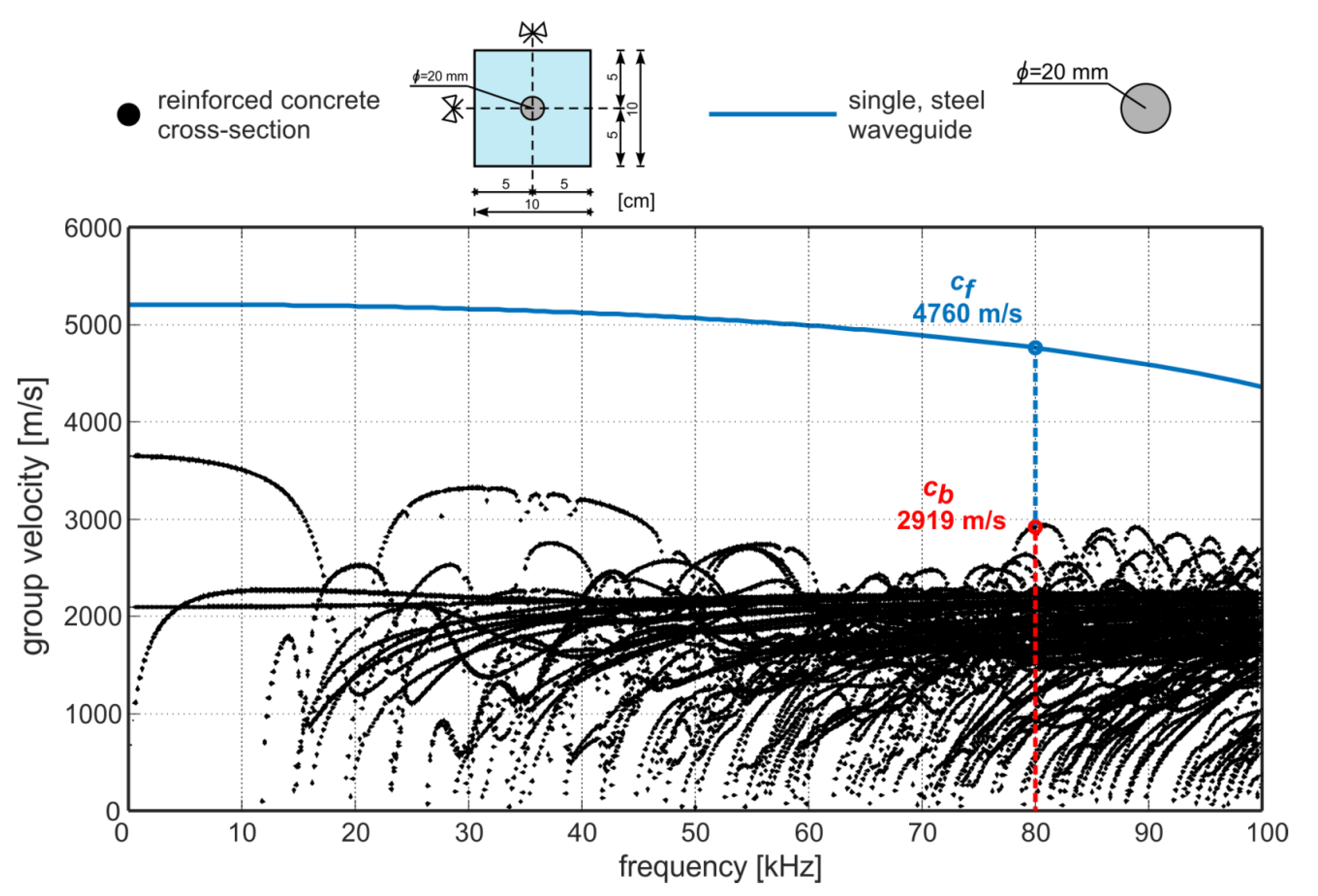
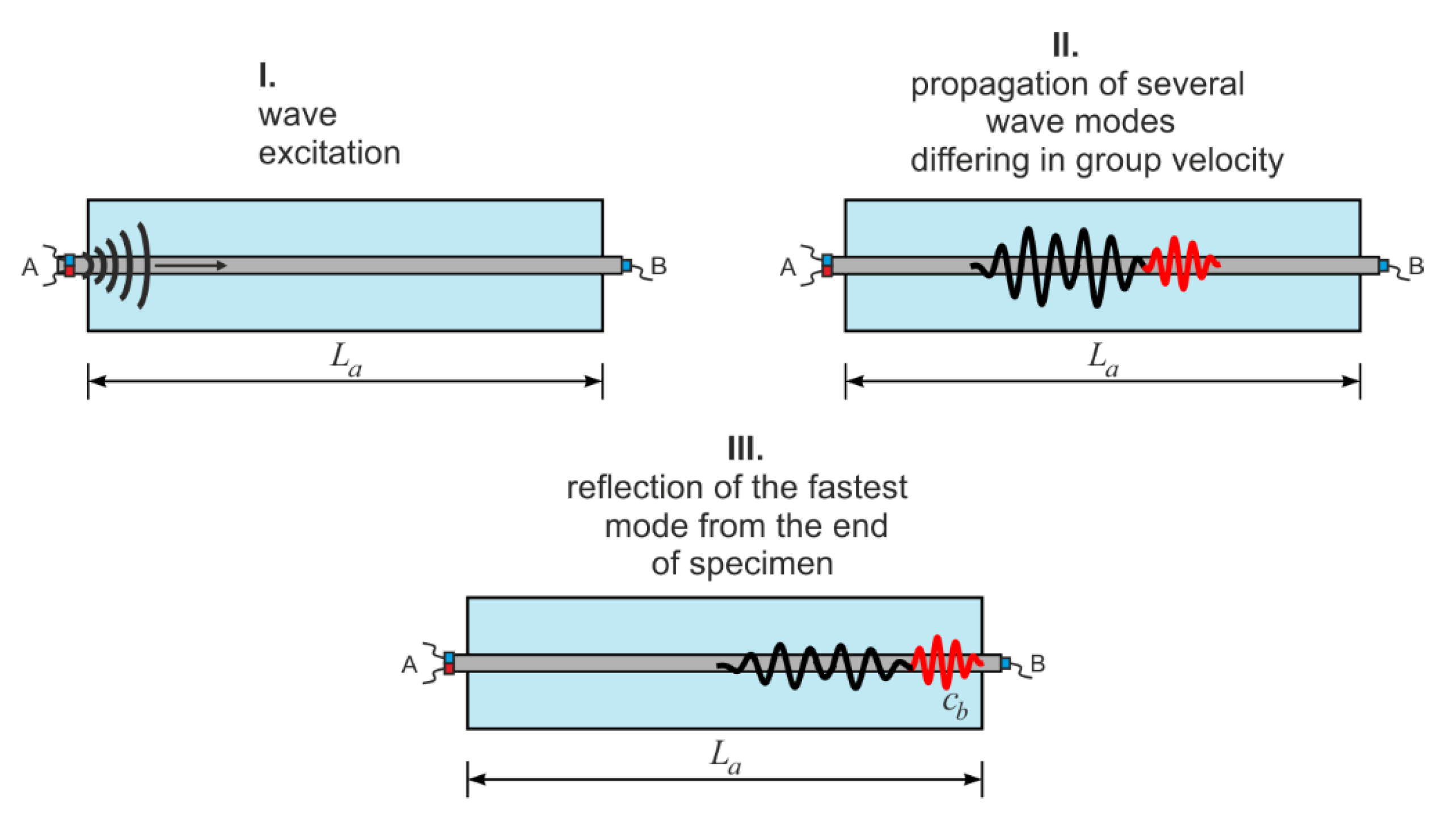
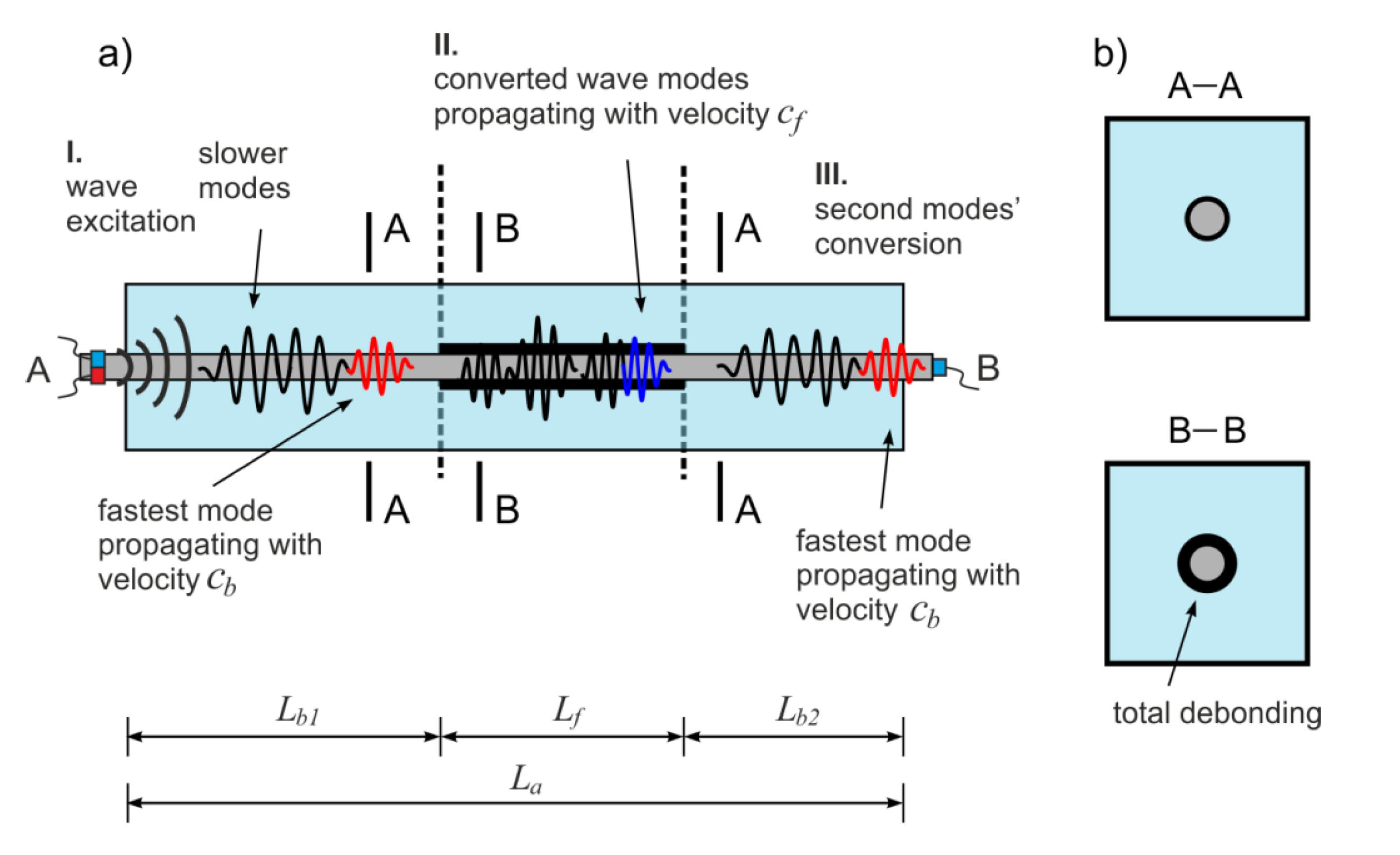
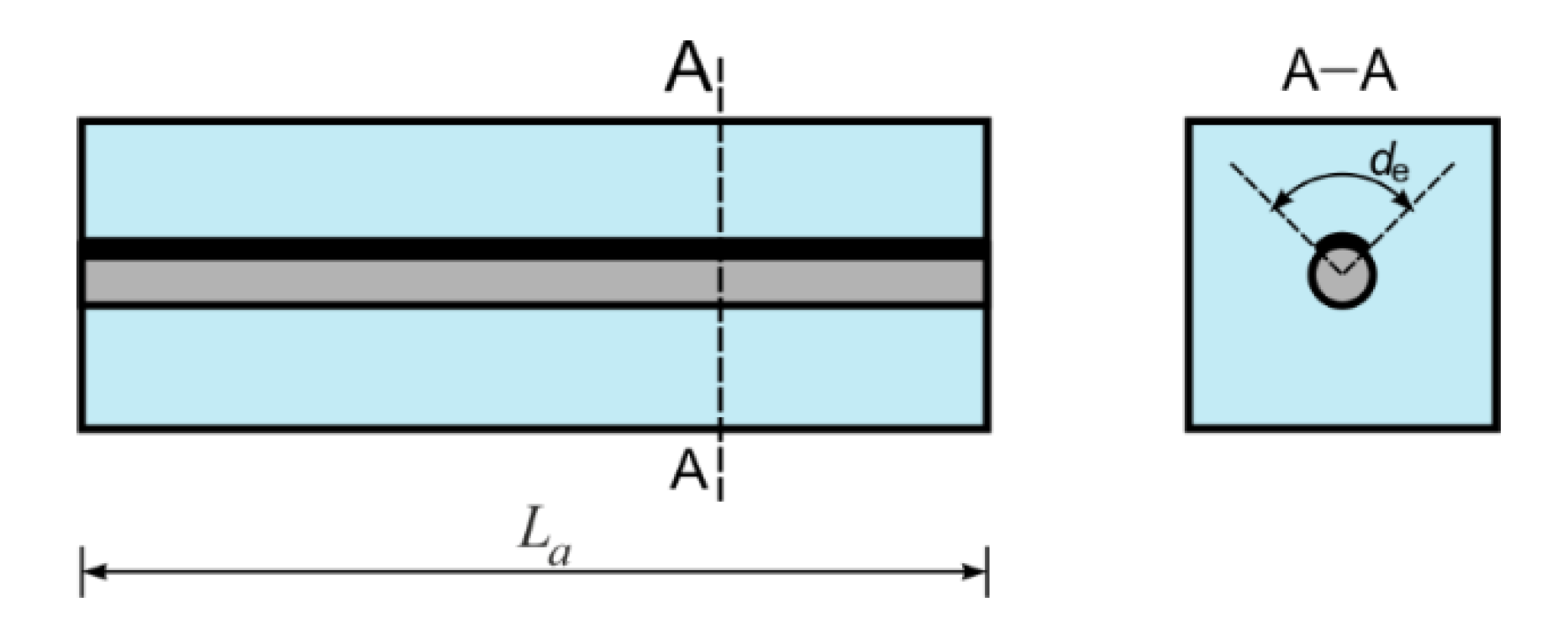

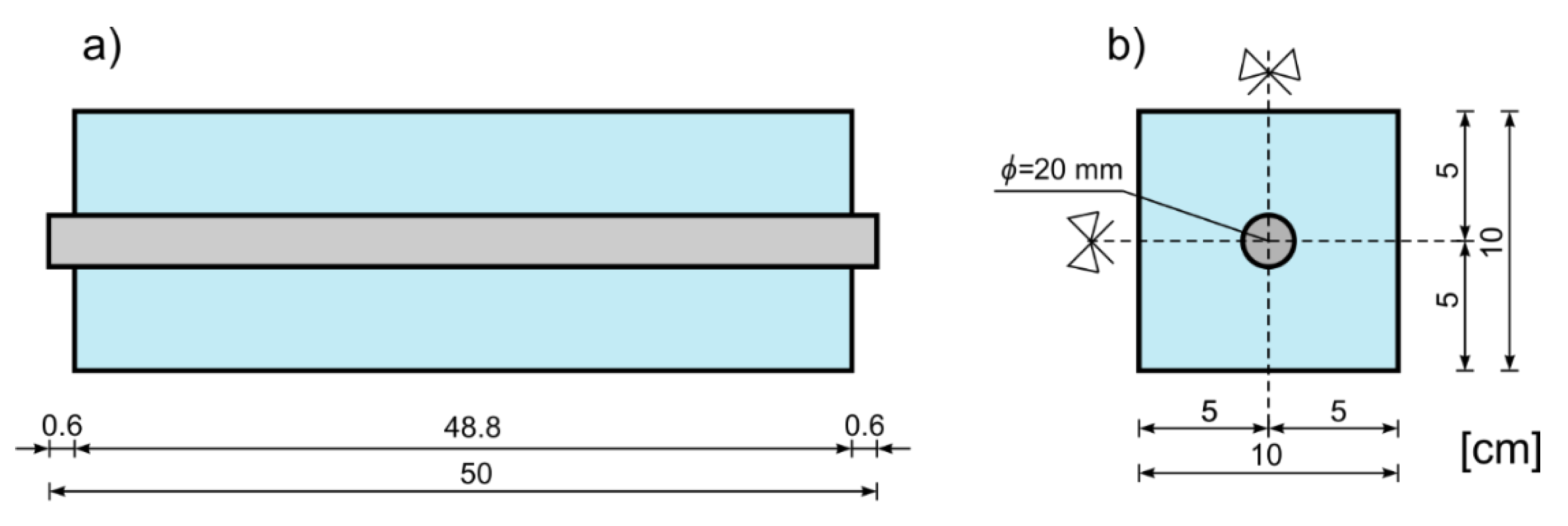


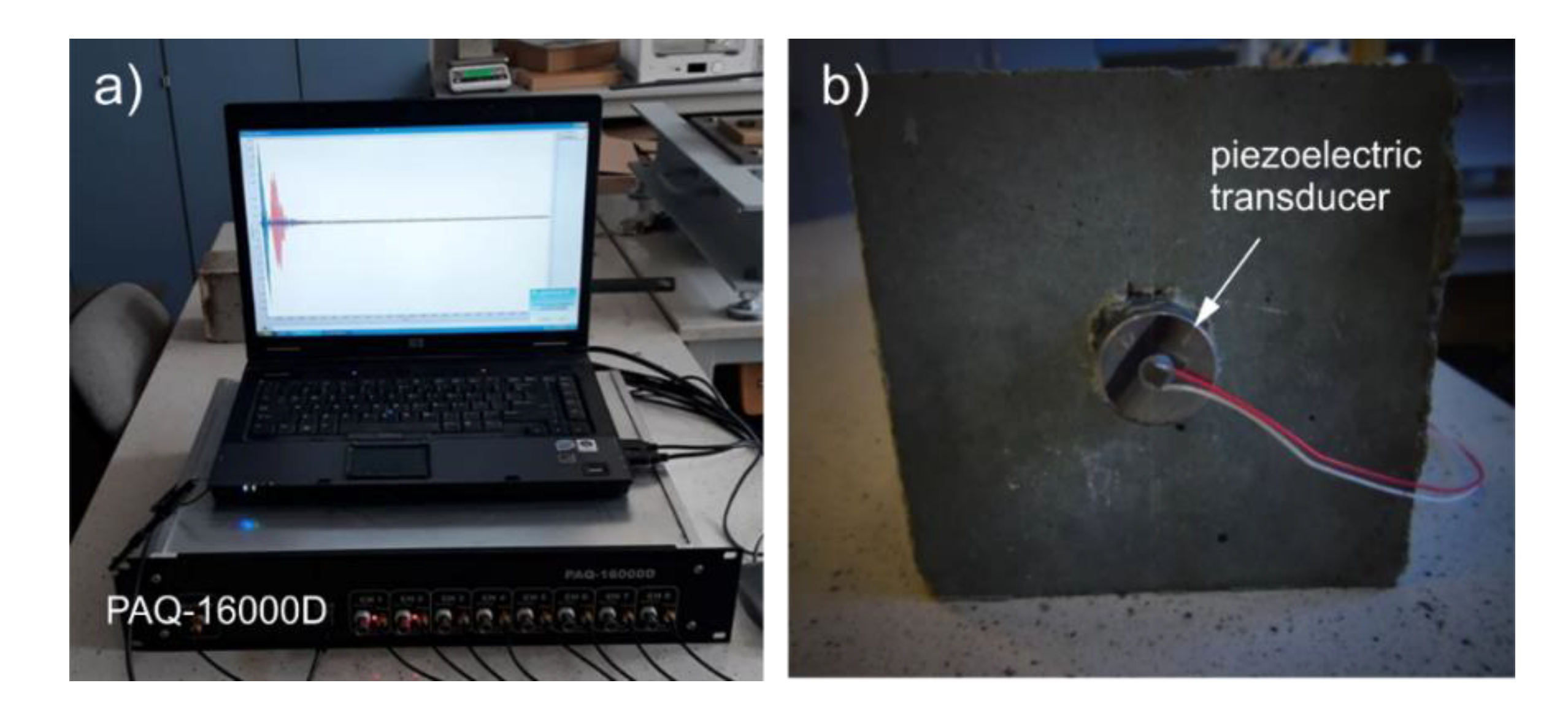
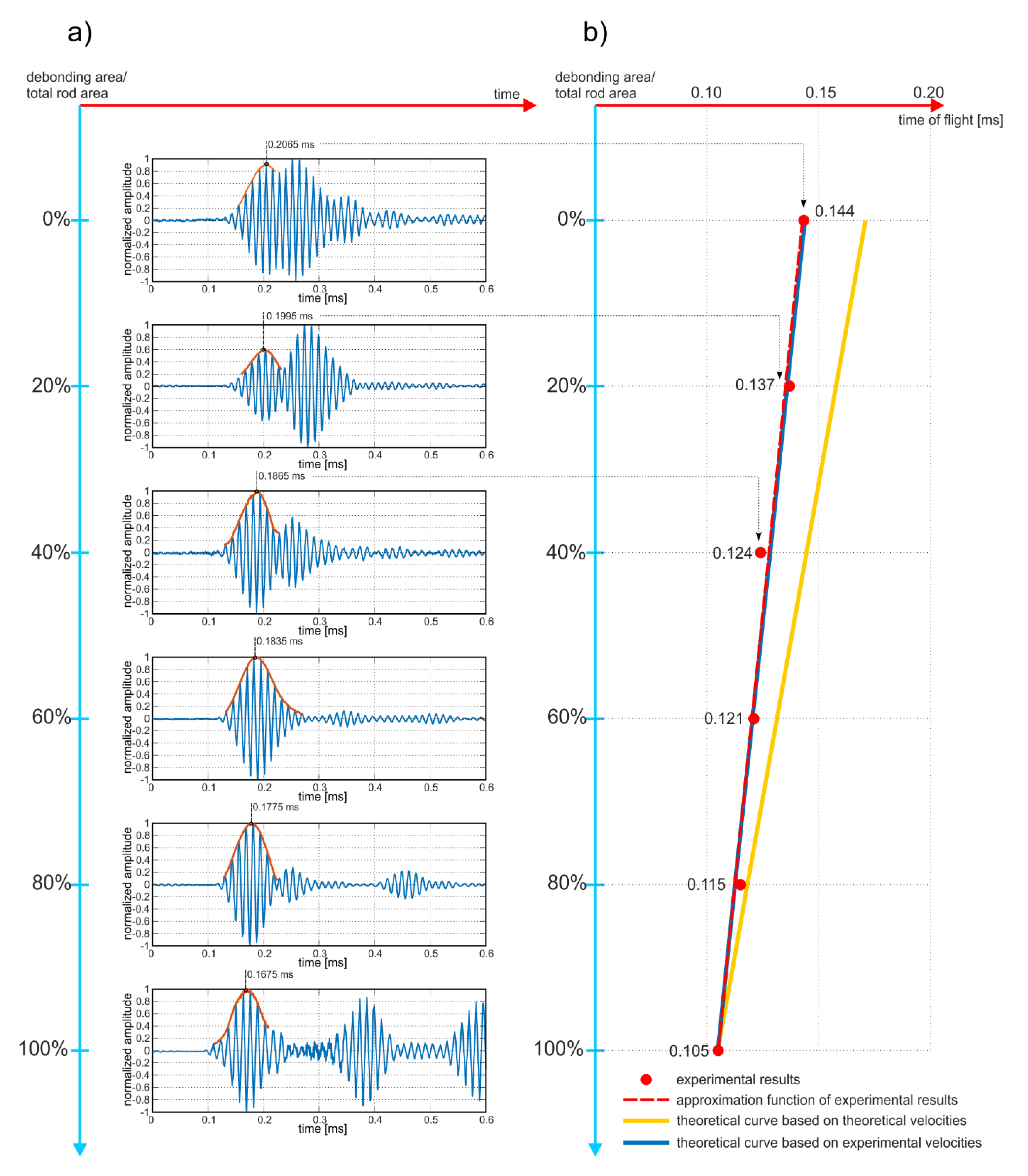

| Beam | Ratio ar [%] | Experimental Average Wave Velocity ca [m/s] |
|---|---|---|
| #A | 0% | 3472.2 |
| #B | 20% | 3649.6 |
| #C | 40% | 4032.3 |
| #D | 60% | 4132.2 |
| #E | 80% | 4347.8 |
| #F | 100% | 4761.9 |
| Beam | Relative Debonding Area ar [%] | Debonding Area Calculated with Use of Experimental Velocities | Percent Error δe | Debonding Area Calculated with Use of Theoretical Velocities | Percent Error δt |
|---|---|---|---|---|---|
| #A | 0% | 0 | 0% | 41% | 41% |
| #B | 20% | 17.94% | 2.06% | 51.75% | 31.75% |
| #C | 40% | 51.29% | 11.29% | 71.4% | 31.4% |
| #D | 60% | 58.97% | 1.03% | 75.9% | 15.9% |
| #E | 80% | 74.36% | 5.64% | 84.97% | 4.97% |
| #F | 100% | 100% | 0% | 100% | 0% |
© 2020 by the authors. Licensee MDPI, Basel, Switzerland. This article is an open access article distributed under the terms and conditions of the Creative Commons Attribution (CC BY) license (http://creativecommons.org/licenses/by/4.0/).
Share and Cite
Zima, B.; Kędra, R. Debonding Size Estimation in Reinforced Concrete Beams Using Guided Wave-Based Method. Sensors 2020, 20, 389. https://doi.org/10.3390/s20020389
Zima B, Kędra R. Debonding Size Estimation in Reinforced Concrete Beams Using Guided Wave-Based Method. Sensors. 2020; 20(2):389. https://doi.org/10.3390/s20020389
Chicago/Turabian StyleZima, Beata, and Rafał Kędra. 2020. "Debonding Size Estimation in Reinforced Concrete Beams Using Guided Wave-Based Method" Sensors 20, no. 2: 389. https://doi.org/10.3390/s20020389
APA StyleZima, B., & Kędra, R. (2020). Debonding Size Estimation in Reinforced Concrete Beams Using Guided Wave-Based Method. Sensors, 20(2), 389. https://doi.org/10.3390/s20020389





